A Guide to Choosing the Right Mobility Aid for Older Adults
Choosing a mobility aid is a key decision for maintaining safety and independence. This guide explains how to select the right device by assessing your physical condition, home environment, and daily activities. It covers the functions, benefits, and limitations of common aids, from canes and walkers to wheelchairs and scooters, to help you make an informed choice.
Section I: How to Assess Your Needs
Selecting a mobility aid requires evaluating your needs. Choosing a device based on a single symptom, like poor balance, can lead to a mismatch. For example, a walker that improves stability but is too wide for your home may be abandoned. A full assessment of your physical capabilities, environment, and lifestyle goals is the first step. 1 This approach, which focuses on preventing falls and maintaining an active social life, is more effective than a decision made after a health decline. 4
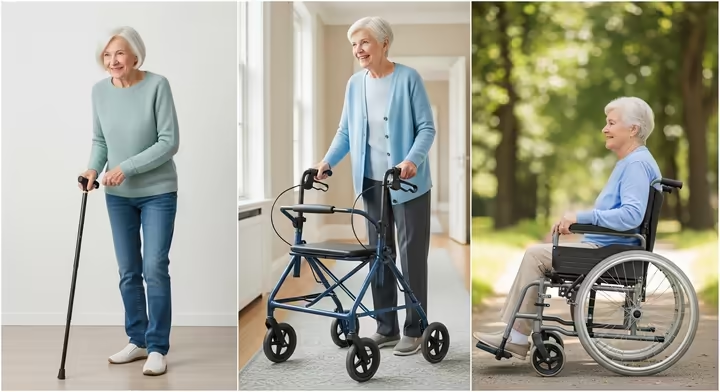
Assessing Your Physical Condition and Capabilities
Understanding your physical status is the basis for selecting a device. This assessment includes balance, strength, endurance, and cognitive function, as these factors determine the type of support required. 8
First, evaluate your balance and stability. Consider if you feel unsteady, dizzy, or have a history of falls or near-falls. 7 The level of balance impairment dictates the necessary base of support. A single-point cane may be sufficient for minor unsteadiness, while a standard walker provides a wider, more stable base for significant balance problems. 8
Your weight-bearing capacity, the ability to support your own body weight, is also important. Determine if you can bear weight fully on both legs or if there is weakness on one side, perhaps from a stroke or hip surgery. A cane can support up to 25% of a user's body weight and is for weakness on one side. 8 In contrast, a walker can support up to 50% of body weight and is necessary for weakness or instability in both legs. 8
Upper and lower body strength is another factor. Using a standard, non-wheeled walker requires enough upper body strength to lift the frame with each step. 8 Similarly, propelling a manual wheelchair requires considerable arm and shoulder strength. 9 For individuals with limited upper body strength, devices that are pushed rather than lifted, such as rollators, or powered devices like wheelchairs and scooters, are more appropriate. 9
Endurance and pain are also vital to the assessment. Consider how far you can walk before feeling tired, short of breath, or in pain. 8 For someone with adequate balance but low endurance, a device that offers a place to rest is essential. A four-wheel rollator, which includes a built-in seat, is a better choice than a standard walker, which does not. 10
Cognitive ability must also be considered. Operating complex mobility aids, particularly powered devices, requires judgment, attention, and visuospatial skills to navigate environments and use controls safely. 9 For this reason, power mobility devices are not recommended for individuals with significant cognitive impairments, dementia, or uncontrolled seizures. 14
Analyzing Your Environment
A mobility aid must be compatible with your daily environment. A device that works well in a clinic may be useless or dangerous in a home or community setting. 6 Therefore, a detailed environmental analysis is an essential part of the selection process.
Consider the primary location of use: indoors, outdoors, or both. A lightweight standard walker may be adequate for a single-story home. 1 However, if you plan to go outside frequently, a device with larger wheels, like a rollator or mobility scooter, is often necessary to handle varied terrain. 6
The terrain and surfaces you encounter daily are very important. Thick carpeting can make it difficult to move a standard walker or manual wheelchair. 9 Outdoors, surfaces like uneven pavement, grass, gravel, or inclines require devices with larger wheels and sometimes pneumatic tires for better traction and shock absorption. All-terrain models of rollators and scooters are designed for these conditions. 15
The layout of your living space must be measured. Assess the width of doorways, hallways, and spaces between furniture to ensure a device can pass through. 9 A standard wheelchair or four-wheel rollator may be too wide for older homes with narrow passages. In such cases, a more maneuverable three-wheel rollator might be a more practical choice, despite offering less stability. 11 The presence of stairs is another critical factor. If you must use stairs regularly, wheeled devices are not an option unless you install ramps or stairlifts. 8 For short-term needs involving stairs, crutches are often the most suitable aid. 8
Defining Your Lifestyle and Goals
The final part of the assessment considers your personal lifestyle and goals. A mobility aid should enable you to continue your desired activities. 14 The right device should match your lifestyle, not just your physical condition.
Your typical activity level is a key consideration. The needs of a homebound person are different from someone who attends community events, shops, or visits friends. 8 For a more active person, a device that promotes endurance and is suitable for outdoor use, such as a rollator with a seat or a mobility scooter, may be essential for maintaining social connections. 8
The need for travel and portability is another lifestyle factor. For those who travel often by car or air, the size, weight, and foldability of a device are primary concerns. Options like folding canes 19 , lightweight rollators 20 , and airline-compliant folding power wheelchairs are relevant here. 21 When planning air travel, understand airline policies regarding assistive devices. They are generally transported free of charge but may have specific requirements for battery-powered chairs. 23
By combining information from these three areas, physical condition, environment, and lifestyle, a clear picture of your mobility needs emerges. This profile allows for a more targeted search for the right device.
| User Characteristic | Cane | Standard Walker | Rollator | Manual Wheelchair | Power Mobility (Chair/Scooter) |
|---|---|---|---|---|---|
| Balance Impairment | |||||
| Mild | Optimal | Suitable | Suitable | Not Recommended | Not Recommended |
| Moderate | Not Recommended | Optimal | Suitable | Suitable | Suitable |
| Severe | Not Recommended | Optimal | Not Recommended | Optimal | Optimal |
| Weight-Bearing | |||||
| Full on Both Legs | Suitable | Suitable | Suitable | Suitable | Suitable |
| Partial/Weak on One Leg | Optimal | Suitable | Suitable | Suitable | Suitable |
| Non-Weight Bearing (One Leg) | Not Recommended | Suitable | Not Recommended | Optimal | Optimal |
| Significant Weakness (Both Legs) | Not Recommended | Optimal | Suitable | Optimal | Optimal |
| Upper Body Strength | |||||
| Good | Suitable | Suitable | Suitable | Optimal | Suitable |
| Fair | Suitable | Suitable | Suitable | Suitable | Suitable |
| Poor | Suitable | Not Recommended | Optimal | Not Recommended | Optimal |
| Endurance Need | |||||
| Low (Short Distances) | Suitable | Suitable | Suitable | Suitable | Suitable |
| High (Long Distances/Rest Breaks) | Not Recommended | Not Recommended | Optimal | Suitable | Optimal |
| Primary Environment | |||||
| Indoor Only | Suitable | Optimal | Suitable | Suitable | Suitable |
| Outdoor/Mixed Terrain | Suitable (with limits) | Not Recommended | Optimal | Suitable (with limits) | Optimal |
| Tight/Narrow Spaces | Optimal | Suitable (with limits) | Optimal (3-wheel) | Suitable (with limits) | Not Recommended |
| Portability Need | |||||
| High (Frequent Car/Air Travel) | Optimal (folding) | Suitable (folding) | Suitable (lightweight) | Suitable (folding) | Suitable (folding models) |
| Low (Primarily Home Use) | Suitable | Suitable | Suitable | Suitable | Suitable |
Section II: Canes, Crutches, and Walking Sticks
For older adults who can walk but need help with balance, stability, or offloading weight, ambulatory aids are the first option. This category includes canes and crutches, which widen the user's base of support and redirect load from the legs to the upper body. Newer aids now include active health monitoring, offering more security for users and their families.
Walking Sticks and Canes
The walking cane is the most common mobility aid, but its effectiveness depends on proper sizing. To determine the correct height, stand up straight in your regular shoes with your arms relaxed. Have someone measure the distance from the floor to the crease of your wrist. This is the ideal height for the cane handle. 24 This sizing ensures your elbow is bent at a comfortable 15 to 20-degree angle, which prevents strain on the shoulder, back, and wrist. 26
Canes are available in several types. The single-point cane is the most basic and is appropriate for those who need minimal balance support or slight weight offloading. 19 For greater stability, multi-point canes are a better option. These include tripod canes (three feet) and quad canes (four feet). The wider base of these canes distributes weight over multiple points, improving stability and preventing tipping. 26 A key advantage of multi-point canes is that they can stand on their own, freeing your hands for other tasks. 19
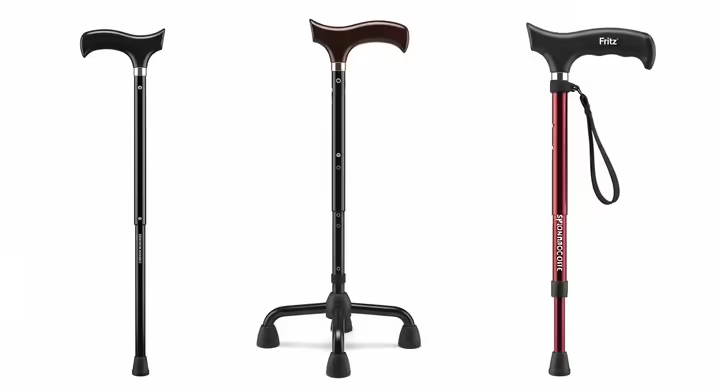
Canes now also incorporate features for comfort and safety. The handle design is important for users with hand pain or arthritis. A "Fritz" handle has a more open shape that reduces pressure on the fingers and palm. 19 Many modern canes have ergonomic, cushioned grips made from foam or gel, which both enhance comfort and absorb shock. 28 Some models have shock-absorbing systems in the cane shaft or tip to mimic the natural flexion of the knee and ankle, promoting a smoother gait. 28 For a user with arthritis, an ergonomic, shock-absorbing handle can be the difference between consistent use and non-compliance due to pain.
The latest innovation is the smart cane. These devices embed sensors, processors, and connectivity into a traditional cane. 30 They provide active monitoring instead of just passive support. Smart canes can analyze gait patterns, providing data to help clinicians detect declines in mobility. Some models have sensors that detect obstacles, while others include fall-detection. This feature can automatically send an alert to pre-programmed contacts if a fall occurs. The cane both helps prevent falls and provides protection when one happens, offering security for older adults who live alone. 30
Crutches
Crutches are typically used for recovery from acute injuries but also serve as a long-term solution for some older adults. They are prescribed when a user must keep all weight off one leg. There are three main types. Axillary crutches, or underarm crutches, are the most common and are for short-term use, such as after a fracture or surgery. 31 They can cause underarm discomfort with prolonged use.
For individuals who need crutches long-term due to a chronic condition, forearm crutches (also called Lofstrand crutches) are often recommended. 31 These have a cuff that encircles the forearm and a handgrip. They require more upper body strength but allow for greater maneuverability and free the hands without setting the crutches down.
A third, more specialized option is the forearm support crutch, or platform crutch. 31 This type has a padded horizontal platform for the forearm and a vertical handgrip. Platform crutches are for individuals who cannot bear weight through their hands or wrists due to conditions like severe arthritis, transferring weight to the forearm instead. 31 While less common, they are a critical option for users who cannot use other walking aids that require hand strength.
Section III: Walkers and Rollators
When a cane is not supportive enough, or when endurance is a limiting factor, walkers and rollators are the next option. These devices offer a much wider and more stable base of support than a cane. However, "walker" and "rollator" describe two different types of devices for distinct needs. The choice depends on whether the user's primary goal is maximizing stability or promoting activity and endurance.
The Defining Comparison, Walker vs. Rollator
The main difference between a standard walker and a rollator is how they interact with the ground. A standard walker is a rigid frame with four legs capped with rubber tips. To move, the user must have enough upper body strength to lift the walker and place it a step ahead before walking into it. 10 This motion creates a highly stable platform. For this reason, standard walkers provide maximum stability and are the right choice for individuals with significant balance impairments, severe weakness, or those who need to offload up to 50% of their body weight. 8
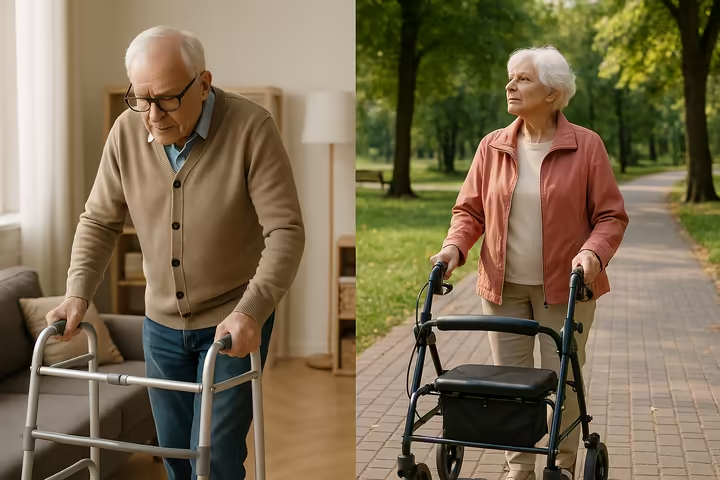
A rollator, in contrast, has wheels on all its legs, either three or four, and is designed to be pushed continuously. 10 This rolling motion allows for a more fluid gait and requires less upper body strength. However, because it is always in motion, a rollator offers less stability than a standard walker and should not be used by individuals who need to bear a large amount of weight on it or who have poor balance. 10 The primary purpose of a rollator is to help users who have good balance but low endurance. Most four-wheel rollators come with a built-in seat and a braking system, allowing the user to lock the wheels and sit down to rest. This extends their range and ability to participate in activities outside the home. 11 The choice highlights a trade-off: a walker offers more stability, while a rollator offers features that enhance endurance.
Types of Walkers
The standard walker, with four non-wheeled legs, remains the best option for maximizing stability. 8 They are often made of lightweight aluminum and are typically foldable for easier storage and transport. 33
A popular alternative is the two-wheel walker. 10 This device has wheels on its two front legs and non-slip glides on its two rear legs. This design is a compromise between a standard walker and a rollator. The user pushes the walker forward on its front wheels, which is helpful for those with limited arm strength. The rear glides provide friction and prevent the walker from rolling away too quickly, offering more stability than a fully wheeled rollator. 11 Two-wheel walkers are well-suited for indoor use and can navigate carpets more easily than a standard walker, though their small wheels are not ideal for rough outdoor terrain. 11
Types of Rollators
Rollators are most common in three- and four-wheel configurations. Three-wheel rollators are lighter, more compact, and offer better maneuverability, making them a good choice for tight spaces. 11 However, their triangular design is less stable than four-wheel models, and they typically do not include a seat. 11
Four-wheel rollators are the most prevalent type, offering a stable, rectangular base. Their defining feature is the integrated seat, which, combined with hand-operated brakes that can be locked, provides a secure place to rest. 11 This makes them ideal for longer excursions, like shopping or walks. They often come with a storage basket. The trade-off is that they are generally heavier and bulkier than three-wheel models. - 11 Rollators are also available with different wheel sizes; larger wheels provide a smoother ride and are better for outdoor surfaces. 16
Advanced and Hybrid Rollators
The market is developing hybrid devices to meet the changing needs of an aging population. An individual's mobility needs can fluctuate, and hybrid devices offer a single, adaptable solution. 9
A standard rollator cannot be used as a transport chair. The seat is for stationary resting only, and the frame is not built to be pushed while someone is seated. Using a standard rollator as a transport chair is dangerous and can lead to device failure and serious injury. 13 However, manufacturers have developed rollator-transport chair hybrids. These devices function as a standard four-wheel rollator but can be converted into a transport chair by flipping the backrest and attaching footrests. 35 This allows a user to walk independently and have a caregiver push them when they become tired.
A more advanced category is the foldable electric rollator walker, often marketed as a 3-in-1 device. These aids combine the functions of a rollator, a transport chair, and a lightweight power wheelchair. 20 They provide walking support in rollator mode. They can then be converted to a chair that a caregiver can push, sometimes with a power-assist feature for slopes. Finally, they can be operated independently by the user via a joystick, functioning as a compact power wheelchair. 22 These devices, such as the Rollz Motion Electric or the Miracle Mobility 4N1, offer adaptability for users with highly variable or progressive mobility challenges. 22
Section IV: Wheelchairs and Scooters
For some mobility impairments, standing and walking, even with a walker, is no longer safe or sustainable. The transition to a wheeled mobility device, such as a wheelchair or scooter, can be a significant step. It is a crucial one for preserving safety, conserving energy, and maintaining independence. Clear signs indicate when ambulatory aids are no longer meeting a user's needs.
Transition Points, From Walker to Wheelchair
The decision to switch from a walker to a wheelchair is typically driven by several key indicators. One is persistent pain during walking. If walking, even with a walker, causes significant pain, a wheelchair can provide relief and prevent further injury. 12 Another critical sign is growing instability. If you experience frequent stumbles or feel unsteady even with a walker, it suggests the walker is no longer providing adequate support, and a seated device is safer. 12
Diminishing endurance is also a major factor. When a person can no longer cover the distances required for daily activities, like getting around their home or going to appointments, their current aid is insufficient. 12 This limitation can lead to social isolation. A wheelchair can restore the ability to navigate longer distances. The transition can be gradual. An individual might start by using a wheelchair only for long outings while continuing to use their walker at home. 12 This approach allows the user to experience the benefits of wheeled mobility without the shock of full-time use.
The Spectrum of Wheeled Aids
The category of wheeled mobility is diverse. A knee scooter, or knee walker, is a specialized, short-term aid for those recovering from a below-the-knee injury. The user rests the knee of their injured leg on a padded platform and propels themselves with their good leg. This allows for mobility without requiring the upper body strength that crutches demand. 15
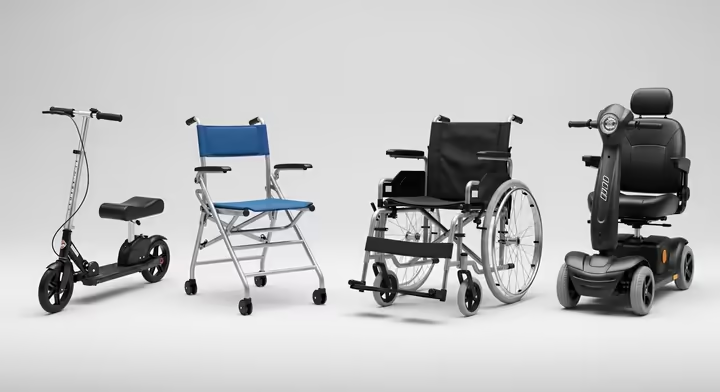
A transport chair has four small wheels and is designed to be pushed by a caregiver. 8 Transport chairs are lightweight, foldable, and portable, making them a good choice for short trips or for users who will always have assistance. They do not allow for independent mobility. 35
A manual wheelchair has large rear wheels with push-rims that allow the user to self-propel the chair. 8 This type is for individuals with enough upper body strength to move themselves independently. It is a suitable option for full-time use by those who cannot walk but wish to maintain an active lifestyle. 14
A power wheelchair is a battery-powered device operated by the user via a joystick. 21 Powerchairs are for individuals who lack the strength to walk or use a manual wheelchair. 8 They provide the maximum level of independent mobility for users with significant physical limitations. Their design often results in a very small turning radius, making them highly maneuverable indoors. 21
A mobility scooter is another form of power mobility but is functionally different from a power wheelchair. A scooter is steered using a T-shaped handlebar system called a tiller, which requires good trunk control and strength in both arms and hands. 14 Scooters have a longer frame and a larger turning radius than powerchairs, making them less ideal for tight indoor spaces. They are best for individuals who can walk short distances but need assistance for longer distances, primarily outdoors. 14 The choice between a powerchair and a scooter is fundamental: a scooter extends the distance for someone with some walking ability, while a powerchair replaces mobility for someone who cannot walk safely.
Section V: Emerging Assistive Technologies
New assistive technologies, including gait trainers, exoskeletons, and self-balancing devices, offer new capabilities for individuals with mobility limitations. They can be classified into three categories: devices for rehabilitation , to help a user relearn a lost function; for augmentation , to enhance a user's existing capabilities; and for replacement , to provide mobility that a user has completely lost. These technologies have high costs and significant hurdles for insurance coverage.
Gait Trainers
Gait trainers are supportive mobility aids for therapeutic use, with the goal of helping a patient relearn walking patterns safely. 39 They are most often used in clinical settings for individuals recovering from a stroke, brain injury, or for those with neurological conditions like cerebral palsy. 41 A gait trainer provides extensive postural support for proper alignment. They often have customizable supports, such as pelvic stabilizers, trunk supports, harnesses, and seats. 39 These features allow a therapist to securely support a patient in an upright, weight-bearing position to practice walking while minimizing injury risk. Gait trainers are rehabilitation tools meant to improve a user's own walking ability over time. 40
Lightweight Consumer Exoskeletons
Exoskeletons are wearable robotic suits that provide powered assistance to the user's limbs. In clinical settings, rehabilitation exoskeletons like the EksoNR are used by physical therapists to mobilize patients with severe neurological impairments. 43
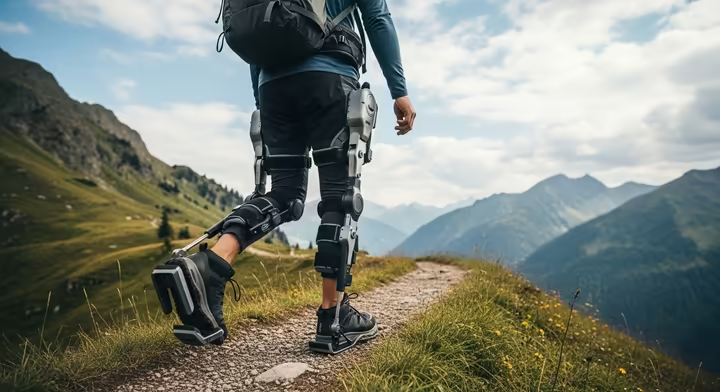
A second category is the personal exoskeleton, such as the Ekso Indego Personal. This is a lightweight device for individuals with paralysis from a spinal cord injury to use at home. 43 These devices function as a mobility replacement, enabling wheelchair users to stand and walk. The U.S. Centers for Medicare & Medicaid Services (CMS) began covering personal exoskeletons in 2024, but only for a specific group of beneficiaries with thoracic-level spinal cord injuries. The devices can cost upwards of $90,000. 43
A third category is the consumer-grade augmentation exoskeleton. Devices like the Hypershell are not for individuals with paralysis but for those who wish to augment their strength and endurance. 45 These lightweight suits are marketed for activities like hiking or physically demanding jobs, providing an electric "boost" to reduce muscle fatigue. 45
Self-Balancing Personal Mobility Devices
Self-balancing personal mobility devices use gyroscopic technology. Products like the Omeo are designed for a high degree of maneuverability. 46 The user is seated on a platform balanced on two parallel wheels. Many can be operated hands-free, with the user steering by shifting their body weight. This frees the hands and provides an intuitive riding experience. With all-terrain tires, these devices can navigate a wide variety of surfaces. They function as a mobility replacement that emphasizes an active user experience. 46 The primary barriers to adoption are high cost and a lack of insurance reimbursement.
Section VI: Cost, Insurance, and Maintenance
Selecting a mobility aid is the first step. The second is navigating the practical and financial realities of acquiring and maintaining it. The cost of mobility aids varies, and understanding insurance rules, particularly Medicare, is essential. Responsible ownership also includes regular maintenance and planning for travel.
Costs and Financial Planning
A basic walking cane can cost as little as $25, with advanced models up to $100. 33 Standard walkers and rollators typically cost between $50 and $500. 33
Wheeled and powered mobility are more expensive. A manual wheelchair can range from a few hundred dollars to several thousand. A mobility scooter generally costs between $1,500 and $4,000. 38 Power wheelchairs are typically the most expensive, with costs starting around $2,000 and climbing to $5,000 or more. 38 The 20% Medicare coinsurance on a $5,000 powerchair is $1,000, which can be a prohibitive amount. 48 This potential out-of-pocket expense must be part of financial planning. A Medicare Supplement (Medigap) or Medicare Advantage plan may help cover these costs.
Navigating Insurance and Medicare
For most older adults in the U.S., Medicare Part B is the primary insurer for mobility aids, which it classifies as Durable Medical Equipment (DME). Medicare will cover them only under strict conditions. 49 The primary rule is that a physician must determine the device is medically necessary for use
in the home . The equipment must be necessary for the patient to safely perform mobility-related activities of daily living (ADLs), such as getting to the bathroom or dressing, within their home. 51
This "in-home" rule is the most critical aspect of Medicare coverage. A desire for a scooter to get to the grocery store is not, by itself, a justification for Medicare coverage. If a cane or walker is sufficient for the patient to manage ADLs inside their home , Medicare will not cover a more expensive device. 48 For a claim to be successful, the physician's documentation must link the need for the device to specific failures in performing ADLs within the home. For example, documentation might state that a patient cannot safely carry a plate of food from the kitchen to the table while using their walker, impairing their ability to feed themselves. 52
The process for obtaining a power mobility device under Medicare for 2025 involves several steps. The beneficiary must have a face-to-face examination with their physician to evaluate their mobility needs. For a power wheelchair, this exam must be no more than 45 days before the physician writes the prescription. 48 The physician must then provide the DME supplier with a written order that documents the medical necessity. For many power wheelchairs, Medicare requires prior authorization. 54 This means the DME supplier must submit all documentation to Medicare for review and approval
before the chair is delivered. This step ensures all coverage criteria are met upfront. 54 If approved, Medicare Part B covers 80% of the approved amount for the DME after the annual deductible is met. The patient is responsible for the remaining 20% coinsurance. 48
Insurance coverage for emerging technologies like gait trainers and exoskeletons is not standardized and requires an individualized process of demonstrating medical necessity. 55 The recent Medicare decision to cover personal exoskeletons for a specific group of spinal cord injury patients is a narrow exception. 43
Maintenance and Travel
Proper maintenance is critical for safety. Users should perform regular safety checks. For walkers and rollators, this includes ensuring handbrakes function correctly. For wheeled devices, check that bolts are tight and tires are properly inflated. 5 Regular cleaning can prevent malfunctions.
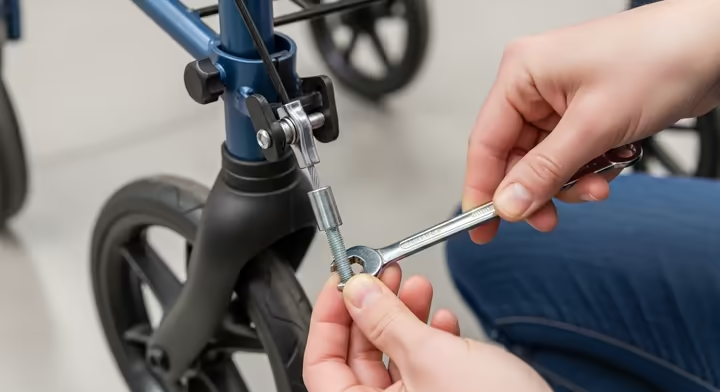
Traveling by air with a mobility aid requires planning. Under the Air Carrier Access Act, airlines must transport personal assistive devices free of charge, and they do not count toward baggage limits. 23 Manual wheelchairs may sometimes be stored in the cabin, but larger devices like power wheelchairs and scooters will be stowed in the cargo hold. Notify the airline in advance of your needs. To prevent damage, attach clear instructions for assembly and disassembly to the device. If the device uses batteries, you must comply with FAA regulations. Upon arrival, the airline must return the device to you near the aircraft door. Inspect your device for any damage and report it to the airline before leaving the gate area. 23
Section VII: Psychological and Social Factors
Adapting to a mobility aid also involves psychological and emotional adjustments. The decision to use an aid can be a challenge to one's identity, forcing a person to confront changes in physical abilities. While there are emotional barriers to adoption, the psychological benefits of using a necessary aid are significant.
Common Barriers to Adoption
A significant hurdle is the emotional adjustment to a new physical reality. It is normal to feel frustrated, angry, or sad when once-easy activities become challenging. 57 These feelings can create resistance to using a device. This resistance is often compounded by social stigma. For many, mobility aids are associated with advanced age and frailty, and the desire to avoid this stigma can override the physical need for support. 58 An individual may resist using a walker to defend their identity as a capable person. The device can feel like a public symbol of a less desirable stage of life. 58 The aesthetic design of a device can play a role; users prefer aids that are more "fashionable" or "sporty" and less clinical in appearance. 58
The Psychological Benefits of Mobility
The psychological benefits of using an appropriate mobility aid far outweigh the barriers. The most profound is the restoration of independence. 2 By enabling an individual to perform daily tasks without assistance, a mobility aid can boost self-esteem and confidence.
Mobility aids also help combat social isolation, a major risk factor for depression in older adults. Fear of falling or fatigue can cause individuals to withdraw from social life. 2 The right device removes these barriers, making it easier to attend family gatherings and community activities. This increased social engagement enhances mental well-being. 3 Furthermore, these devices provide safety and security. By reducing the fear of falling, an aid can alleviate anxiety and empower users to move with greater confidence. 2
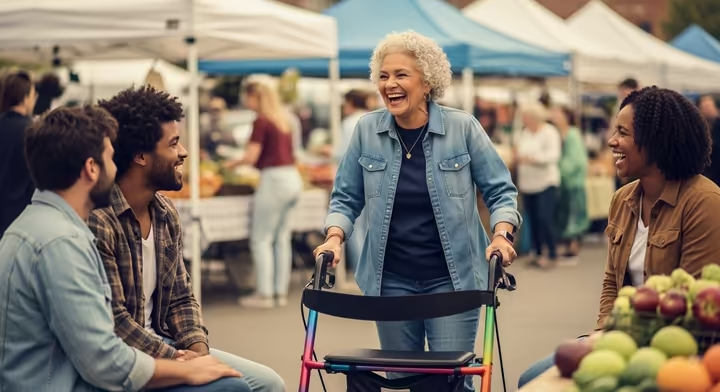
The User Experience, Daily Life and Challenges
The benefits of a mobility aid are affected by the accessibility of the environment. A device intended for freedom can become frustrating if it highlights environmental barriers. Daily life for a mobility aid user often involves extra planning, such as avoiding homes with stairs or stores with narrow aisles, removing throw rugs, or ensuring floors are clean and dry. 17
Travel requires planning to confirm that destinations and transportation are accessible. 60 There is also the challenge of device failure; a dead battery on a powerchair can leave a user stranded. 62 This shows that successful adoption involves both selecting the correct device and assessing the user's home and community environments to make necessary modifications. When the environment is accommodating, the mobility aid can fulfill its promise as an enabler of independence.
Conclusion: Get a Professional Assessment
This guide provides a framework for selecting a mobility aid, but the final step is a professional assessment. A consultation with a physician, physical therapist (PT), or occupational therapist (OT) is essential. These professionals can validate your self-assessment, recommend the most appropriate device, and ensure it is properly fitted to your body. 1 They also provide crucial training on how to use the aid safely, navigate different environments, and perform transfers correctly. This professional guidance helps maximize the benefits of mobility support while minimizing risks, paving the way for sustained independence and an improved quality of life.
Works cited
- 5 Tips To Choose The Best Mobility Aids For Your Loved Ones - Veranda Club, accessed July 9, 2025, https://verandaclub.com/5-tips-to-choose-the-best-mobility-aids-for-your-loved-ones/
- The Psychological Benefits of Mobility Aids, accessed July 9, 2025, https://comfygomobility.com/blogs/news/the-psychological-benefits-of-mobility-aids
- Exploring the Psychological Impact of Mobility Assistance Devices - Redman Power Chair, accessed July 9, 2025, https://www.redmanpowerchair.com/exploring-the-psychological-impact-of-mobility-assistance-devices/
- Fall prevention: Simple tips to prevent falls - Mayo Clinic, accessed July 9, 2025, https://www.mayoclinic.org/healthy-lifestyle/healthy-aging/in-depth/fall-prevention/art-20047358
- Wheelchair Assessment - Physiopedia, accessed July 9, 2025, https://www.physio-pedia.com/Wheelchair_Assessment
- 5 Essential Tips for Choosing the Right Mobility Aids for Your Needs, accessed July 9, 2025, https://parkermedicalequipment.net/blog/5-essential-tips-for-choosing-the-right-mobility-aids-for-your-needs
- POCKET GUIDE Preventing Falls in Older Patients - CDC, accessed July 9, 2025, https://www.cdc.gov/steadi/media/pdfs/steadi-pocketguide-508.pdf
- Choosing Your Ideal Mobility Aid: Find the Perfect Fit, accessed July 9, 2025, https://www.mobilitypluscolorado.com/blog/what-mobility-aid-is-right-for-you
- How to Select the Appropriate Mobility Aid: Walkers, Standard Wheelchairs, and Powered Wheelchairs for Home Health and Hospice Patients, accessed July 9, 2025, https://www.coastalhospice.net/blog/how-to-select-the-appropriate-mobility-aid-walkers-standard-wheelchairs-and-powered-wheelchairs-for-home-health-and-hospice-patients
- When You Need a Walker or Rollator | The Mobility Aids Centre Ltd, accessed July 9, 2025, https://www.themobilityaidscentre.co.uk/blog/when-you-need-a-walker-or-rollator/
- Walkers and Rollators what you need to know - Harmony Home Medical, accessed July 9, 2025, https://harmonyhomemedical.com/pages/types-of-walkers
- 3 Signs That It Might Be Time To Move From a Walker to a Power Chair - Karma Mobility, accessed July 9, 2025, https://www.karmamobility.co.uk/2021/07/20/3-signs-that-it-might-be-time-to-move-from-a-walker-to-a-power-chair/
- Can a rollator be used as a wheelchair? - Triumph Mobility, accessed July 9, 2025, https://triumphmobility.com/can-a-rollator-be-used-as-a-wheelchair/
- Wheelchair and Power Mobility for Adults | PM&R KnowledgeNow, accessed July 9, 2025, https://now.aapmr.org/wheelchair-and-power-mobility/
- Best Knee Scooter & Knee Walkers | KneeRover | All Terrain Knee Walker, accessed July 9, 2025, https://kneerover.com/
- 2025's Best Mobility Aids: Boost Independence & Comfort, accessed July 9, 2025, https://medmobilityhomecare.com/2025-top-mobility-aids-and-solutions/
- A Day in the Life: Living with a Mobility Aid, accessed July 9, 2025, https://assistmobility.co.uk/blogs/news/a-day-in-the-life-living-with-a-mobility-aid
- Fitness advice for wheelchair users - NHS, accessed July 9, 2025, https://www.nhs.uk/live-well/exercise/wheelchair-users-fitness-advice/
- The Four Best Types of Walking Canes - Caring Village, accessed July 9, 2025, https://caringvillage.com/product-review/best-walking-canes/
- Power Walker - Walmart, accessed July 9, 2025, https://www.walmart.com/c/kp/power-walker
- Electric & Motorized Wheelchairs for Sale - Scootaround Store, accessed July 9, 2025, https://www.scootaroundstore.com/collections/electric-wheelchairs
- Miracle Mobility 4N1 Electric Walker Wheelchair - Scootaround Store, accessed July 9, 2025, https://www.scootaroundstore.com/products/miracle-mobility-4n1-electric-walker-wheelchair
- Wheelchairs and Other Assistive Devices | US Department of Transportation, accessed July 9, 2025, https://www.transportation.gov/individuals/aviation-consumer-protection/wheelchairs-and-other-assistive-devices
- How Tall Should Your Walking Stick Be? - WalkingSticks.co.uk, accessed July 9, 2025, https://www.walkingsticks.co.uk/blog/how-tall-should-your-walking-stick-be.html
- Sizing Guide - Brazos Walking Sticks, accessed July 9, 2025, https://www.brazos-walking-sticks.com/pages/sizing-guide
- Top Benefits of Using a Tripod Stick for Walking: Stability and Comfort Explained, accessed July 9, 2025, https://vissconext.com/blogs/articles/top-benefits-of-using-a-tripod-stick-for-walking-stability-and-comfort-explained
- Step Out in Confidence With The Right Type of Cane - Equip2Adapt, accessed July 9, 2025, https://equip2adapt.com/blog/types-of-canes/
- Hugo® Derby Handle Canes, accessed July 9, 2025, http://www.hugoanywhere.ca/products/hugo-derby-handle-canes/
- Ergocane Ergonomic Walking Cane- Black Matte - Maxi Aids, accessed July 9, 2025, https://www.maxiaids.com/product/ergocane-ergonomic-walking-cane-black-glossy
- What Are Smart Canes? - Nursing Knowledge Exchange - YouTube, accessed July 9, 2025, https://www.youtube.com/watch?v=s_kFke4N8yI
- What Are the Different Types of Crutches? - Healthline, accessed July 9, 2025, https://www.healthline.com/health/bone-health/crutches-types
- myplanmanager.com.au, accessed July 9, 2025, https://myplanmanager.com.au/benefits-of-a-rollator-vs-a-standard-walker/#:~:text=Simply%20speaking%2C%20the%20most%20significant,has%20a%20seat%20and%20storage.
- 15 Best Assistive Devices for Elderly [Tested & Rated for 2025] - Resource for Seniors and Caregivers | SeniorSite, accessed July 9, 2025, https://seniorsite.org/resource/15-best-assistive-devices-for-elderly-tested-amp-rated/
- triumphmobility.com, accessed July 9, 2025, https://triumphmobility.com/can-a-rollator-be-used-as-a-wheelchair/#:~:text=The%20seat%20on%20a%20rollator,wheelchair%20could%20pose%20safety%20risks.
- Wheelchair vs Transport chair: do you know the difference? - Triumph Mobility, accessed July 9, 2025, https://triumphmobility.com/transport-chair-vs-wheelchair/
- Reviews of Rollz rollators from real users, accessed July 9, 2025, https://www.rollz.com/reviews/
- Lightweight Electric Wheelchair | Foldable & Portable - ROLLZ, accessed July 9, 2025, https://www.rollz.com/rollator-walkers/electric-wheelchair/
- Electric Wheelchair vs. Mobility Scooter - Aging with Dignity, accessed July 9, 2025, https://agingwithdignity.org/resource-directory/electric-wheelchair-vs-mobility-scooter/
- Gait Trainers for Adults, Pediatrics, Toddlers - Vitality Medical, accessed July 9, 2025, https://www.vitalitymedical.com/gait-trainers-safety-roller.html
- Adult Gait Trainers for Walking Rehabilitation, accessed July 9, 2025, https://www.prohealthcareproducts.com/adult-gait-trainers/
- How to Incorporate Functional Mobility into Rehab After Surgery | Blog - St. James Rehabilitation and Healthcare Center, accessed July 9, 2025, https://www.stjamesrehab.com/blog/how-to-incorporate-functional-mobility-into-rehab-after-surgery
- How to Choose an Adult Gait Trainer - Rehabmart.com, accessed July 9, 2025, https://www.rehabmart.com/post/product-review-the-top-five-gait-trainers
- Home - Eksobionics, accessed July 9, 2025, https://eksobionics.com/
- Virginia man among first to get exoskeleton covered by Medicare - YouTube, accessed July 9, 2025, https://www.youtube.com/watch?v=XlMnA2QQAs4
- Hypershell: World's First Outdoor Exoskeleton for Hiking & Daily Use – Hypershell Global, accessed July 9, 2025, https://hypershell.tech/
- Omeo America: Hands-Free, Self-Balancing Personal Mobility Device, accessed July 9, 2025, https://myomeo.com/
- Electric Wheelchair Cost, accessed July 9, 2025, https://bestpowerwheelchair.com/pages/electric-wheelchair-cost
- Are Wheelchairs Covered by Medicare? Yes, Here's How - GoodRx, accessed July 9, 2025, https://www.goodrx.com/insurance/medicare/wheelchair-coverage
- Medicare Durable Medical Equipment | MedigapSeminars, accessed July 9, 2025, https://medigapseminars.org/medicare-durable-medical-equipment/
- Durable Medical Equipment (DME) coverage - Medicare, accessed July 9, 2025, https://www.medicare.gov/coverage/durable-medical-equipment-dme-coverage
- Medicare coverage of wheelchairs and scooters., accessed July 9, 2025, https://www.medicare.gov/publications/11046-medicare-coverage-of-wheelchairs-scooters.pdf
- Medicare Policies for Mobility Assistive Equipment | Neuropt.org, accessed July 9, 2025, https://www.neuropt.org/docs/default-source/wheel-chair-curriculum/medicare-policies-for-mobiilty-assistive-equipment.pdf?sfvrsn=e54c5f43_2
- APTA: MOBILITY DEVICE CLINICAL DOCUMENTATION GUIDE, accessed July 9, 2025, https://www.neuropt.org/docs/default-source/wheel-chair-curriculum/general-mobility-device-clinical-documentation-guide.pdf?sfvrsn=d04c5f43_2
- Wheelchairs & scooters - Medicare, accessed July 9, 2025, https://www.medicare.gov/coverage/wheelchairs-scooters
- Frequently asked questions | SUITX, accessed July 9, 2025, https://www.suitx.com/en/exoskeleton-faq
- Standing Devices and Gait Trainers - Excellus BlueCross BlueShield, accessed July 9, 2025, https://www.excellusbcbs.com/documents/d/global/exc-prv-standing-devices-and-gait-trainers-1
- Coping with a New Disability and Mobility Equipment, accessed July 9, 2025, https://nmeda.org/coping-with-a-new-disability-and-mobility-equipment/
- Perspectives on Use of Mobility Aids in a Diverse Population of Seniors: Implications for Intervention - PMC, accessed July 9, 2025, https://pmc.ncbi.nlm.nih.gov/articles/PMC2768139/
- Perceived Inclusivity in Mobility Aids Use: A Qualitative Study in Iran - MDPI, accessed July 9, 2025, https://www.mdpi.com/2673-7272/5/1/15
- 8 things that can make a mobility impaired person's daily life easier - Shower Buddy., accessed July 9, 2025, https://shower-buddy.com/blogs/news/8-things-that-can-make-a-mobility-impaired-person-s-daily-life-easier
- Check For Safety A Home Fall Prevention Checklist For Older Adults - CDC, accessed July 9, 2025, https://www.cdc.gov/steadi/pdf/steadi-brochure-checkforsafety-508.pdf
- The Advantages And Disadvantages Of Using Mobility Aids With PsA, accessed July 9, 2025, https://psoriatic-arthritis.com/living/mobility-aid-advantages